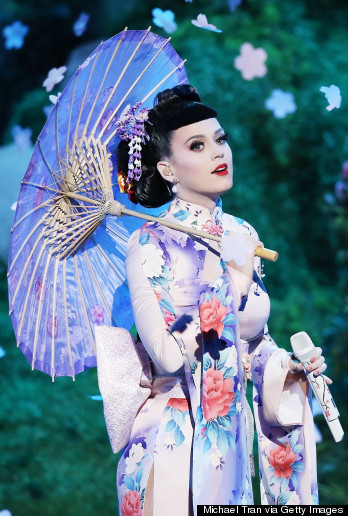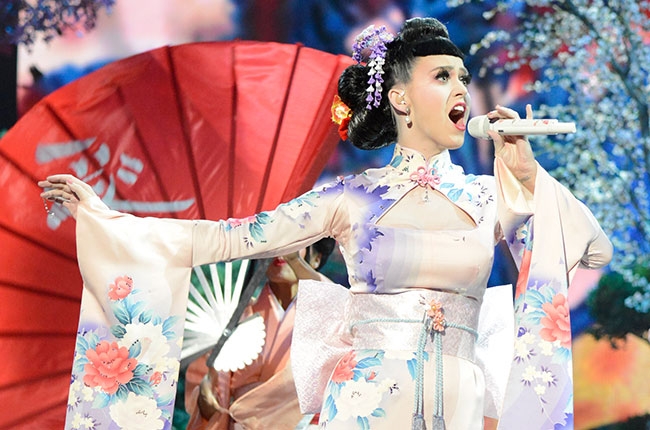
For most Americans — nearly 11 million by Nielsen ratings — this past Sunday night was the airing of the second half of The Walking Dead‘s two-part Governor back-story post hoc origin story. For about 5 million TV viewers — that’s right, less than half of those who tuned in for a random The Walking Dead episode — Sunday night was the AMA Music Awards (that’s “American Music Awards” for all you Redditors; although, in retrospect, there should totally be “Ask Me Anything” awards).
One of you 5 million viewers blew the Internet up when you let the rest of us know that the Awards was opened by Katy Perry in the latest Orientalist catastrophe to invade our living rooms. A lot of Asian Americans (and media critics in general) commented yesterday about it.
I didn’t, because I was in the middle of the Yale gunman scare all day. Turns out that if even an hour of your day is spent contemplating the room at work that you’re going to turn into a (hopefully) bullet-proof safehouse, you end up way too distracted to write about arguably meaningless stuff like pop culture. Who knew?
But, this afternoon, I finally buckled down and watched all four minutes of the Katy Perry opening act of the AMAs. And, yep, it’s pretty racist: YouTube video, and my commentary after the jump.
http://www.youtube.com/watch?v=TC1A62vEe8k
Mandolins. Taiko drums. Fans. Umbrellas. Lanterns. Cherry blossoms. Powdered faces. Shinto shrines. Calligraphy-inspired backdrops. Unnatural hybrids of kimono & chi pao. Black wigs in chop-sticked up-dos. Bright red lips coloured into a perpetual purse. Dramatic eyeliner used to mimic the East Asian slanted eye. Shuffling white-socked feet and hands clapped together in a stiff ohaiyo bow. A freakin’ tea garden. This set couldn’t have been more Orientalist if they had started throwing Pocky boxes and teabags wrapped in tiny tatami mats at the audience. (Wait, are we sure they didn’t do that?)
Like it always is, it’s a giant puddle of “East Asian-inspired” half-digested vomit: familiar chunks of things that still vaguely resemble their input material can be discerned, but it’s all floating in a soupy, foul-smelling gmish of indescribable disaster and half-chewed carrots.
And what I have to wonder is: why is it always like this?

Katy Perry’s AMA Orientalism is only the latest in a long tradition of over-the-top Western appropriation of Eastern culture in music. Nicki Minaj in a kimono or ripping from K-pop; Selena Gomez in a bindi; the unabashed minstrelsy of Gwen Stefani’s Harajuku Girls; Britney Spears in a kimono surrounded by white-clad ninja (pictured above); Christina Aguilera singing (the unreleased) “Kimono Girl” with lyrics like “Kimono girl’s a pleasure
/An unknown nasty treasure. /She’ll make all your wishes complete.”; whatever the heck is going on in this Black Eyed Peas music video.
The original modern-day pop diva Orientalist is easily Madonna, who was offending Asian cultures like she was collecting Pokemon. From bindi to kimono, nothing was sacrosanct to Madonna if it was from the East (although, to be fair, she was sort of an equal opportunity appropriation artist, and didn’t limit herself to just Asian stuff). I mean, seriously, there isn’t a more creative thieving than plastic kimonos and epileptic Asian women in straight jackets:
httpv://www.youtube.com/watch?v=cAVx9RKaLPU
They say that every pop princess diva since Madonna has been trying to be Madonna. And, in cultural appropriation, certainly a lot of these women are trying to out-Asian her. But, most are failing: Katy Perry’s AMA set was big, showy, but ultimately a yawn-inducing and uninspired example of Orientalism.
And why Orientalism? Why, for example, aren’t we seeing a slew of women donning lederhosen, eating schnitzel, and artfully yodeling?
Since before Marco Polo first traveled the Silk Road and Matthew Perry sailed into Tokyo Bay, the East — or more specifically, the West’s rigid fantasy of the East — has held a fascination that continues into today. It is one that is, by definition, all silk fans and tea leaves and hypersexualized women, and that bears only superficial resemblance to its real-life inspiration. Writes Edward Said in “Orientalism“:
The Orient that appears in Orientalism, then, is a system of representations framed by a whole set of forces that brought the Orient into Western learning, Western consciousness, and later, Western empire.… The Orient is the stage on which the whole East is confined. On this stage will appear the figures whose role it is to represent the larger whole from which they emenate. The Orient then seems to be, not an unlimited extension beyond the familiar European world, but rather a closed field, a theatrical stage affixed to Europe.
It is precisely this exotic, erotic fiction that appeals to pop music, and specifically to music videos and awards ceremonies. These are settings where all the acts — and not just the Orientalist vomit ones — are intended to be theatrical, larger-than-life, and over-the-top. Gone are the days when a lone man could wow us with nothing more than a spotlight, a smoke machine, and an unparalleled dance move.
httpv://www.youtube.com/watch?v=KwBehV9U46s
Contemporary artists aren’t that any more. Now, they sell the unusual, the bizarre, the fantasy. They define themselves and are defined by how much of a character they are, and sell more records the farther they push the boundaries of “normalcy”. They do things to make us look at them (when we’d rather be watching The Walking Dead): Robin Thicke filmed a music video surrounded by literally naked women; Chris Brown danced on tables; Cee Lo Green has a parrot on The Voice; Britney Spears and Christina Aguilera kissed Madonna (which was shocking, once); Lady Gaga wore a meat dress; Miley Cyrus pranced on-stage with life-sized teddy bears and rubbed a foam finger on her fully-clothed clitoris.
In this context, Asian drag against a backdrop of Edward Said’s Orientalism circus theatrics fits right in.
The problem is that it shouldn’t.
My issue with Katy Perry — and Gwen Stefani and Selena Gomez and Britney Spears and Madonna before her — isn’t really the Power Girl-inspired boob window, the lack of Asian dancers, or the falling cherry blossoms plastered over auto-tuned warbling of a forgettable song about submissive women. It’s not that Perry’s kimono isn’t really a kimono and that it’s really a chi pao — although, yes, all those things are true.

No, the problem here is that, even after two centuries, Edward Said’s idea of Orientalism persists. It’s that non-Asian people still feel entitled to appropriate aspects of my people’s history and culture — my people’s very identity — and re-render it in over-saturated hues under the modern-day equivalent of a circus big top to satisfy their own notions of self-distinction. It’s that if you go into any vintage store, you’ll find throw-away chi pao-inspired fashion from that era in the 90’s when everyone (myself included, I’m ashamed to say) wanted to appropriate Asian-ness. It’s that those import-export Asian tchotchke stores that sell knock-off samurai swords and ceramic tea pots in the mall have a clientele.
There was a time, not long enough ago, when Asian men and women were considered bonafide “freaks”, as aberrant as the bearded lady and the Lobster boy. In fact, the first documented Chinese woman in the United States was believed to be Afong Moy, a Chinese woman who was advertised to paying gawkers as an Oriental princess in a travelling sideshow exhibit.
But, there are no humans with individuality and lived experiences under the big top. There are no people in petting zoos; only sub-human things to be admired and appropriated, gawked at and feared, consumed and discarded.
For artists performing in venues like the AMA’s, Orientalist vomit is a short-cut for non-Asian artists to achieve easy (but lazy) “edginess”. When Katy Perry dons yellowface, she may not be maliciously racist — but nonetheless she is willfully perpetuating the idea that Asia and Asians are a foreign thing to be stared at, gawked at, exoticised and dehumanized. With every knot tied into her wannabe obi, Katy Perry perpetuates the same Orientalism that says: “it’s okay to treat Asia like a foreign world, and Asians like its alien inhabitants.”
In Orientalism, Asia is no longer a collection of varied cultures, or a people’s history, but a category of stage prop, a genre of sampled music, a superficial style of art design.
I wrote this three years ago, but it bears repeating:
Asian cultures have a rich and varied history, but in these videos, they are appropriated with as much depth as the Auto-Tune of the songs themselves, and regurgitated onto each scene as little more than a superficial, stylized, exoticized patina.
I welcome the day that Katy Perry’s mundane Orientalism no longer intrigues or titillates Western audiences. But if history is any indication, Orientalism has been going strong for at least two centuries with no sign of waning. Katy Perry is only the latest offensively uninspired and criminally lazy offender.
At least until the next one comes along.
